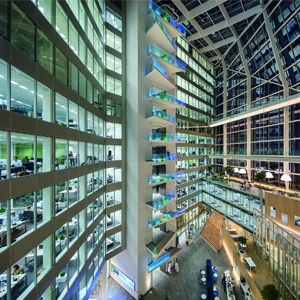How will our buildings change when your mobile device can receive huge amounts of data flowing from the luminaires above you? Not only has LED brought us a highly efficient light source, but a promising instrument for visible light communication (VLC) as well. Therefore light will not only be a medium to support vision, but it will also be an essential means of data communication. With the low energy consumption of LED one can even set up luminaires without mains cables for the power and just install Ethernet cables. Welcome to the world of digital lighting!
Outdated incandescent light sources demanded high power consumption, with cables to match, to achieve a sufficient light output. However, modern LED fixtures require much less power for strong accent or general lighting. Therefore engineers can apply alternative techniques to power the lighting. “Power over Ethernet” (PoE) is a technology in which electrical power is provided through Ethernet cables, which IT networks use and plug into a router with an easy click.
Originally designed to transport data, Ethernet cables can carry a certain wattage like current LED luminaires – combining power and communication. The Ethernet cables for this application are cheap and easy to install and consequently help to save installation costs. When connected to other interfaces like presence sensors and climate and security systems, the network can aggregate real-time data to control the building in a more differentiated way.
 “The Edge,” a new landmark office building for sustainable design in Amsterdam designed by PLP Architecture, is one building where this technology has been used in thousands of luminaires throughout the entire architecture. But PoE cabling is just one part of the digital lighting movement. Visible light communication leads to another fascinating innovation track.
“The Edge,” a new landmark office building for sustainable design in Amsterdam designed by PLP Architecture, is one building where this technology has been used in thousands of luminaires throughout the entire architecture. But PoE cabling is just one part of the digital lighting movement. Visible light communication leads to another fascinating innovation track.
Harald Haas, professor of mobile communication at the University of Edinburgh, is a pioneer of visible light communication. In a 2011 demonstration at TED in Edinburgh, Haas unveiled Li-Fi, or Light Fidelity for the first time. Li-Fi is a category of optical wireless communication using the same visible spectrum as used for architectural illumination. As LEDs are semi-conductor devices, the current and the optical output can be modulated at extremely high speeds, which is imperceptible to our eyes. Some tests have shown that Li-Fi can be 100 times faster than Wi-Fi. In his 2015 TED talk Haas linked the Li-Fi technology to solar cells as a receiver, enabling additional harvesting of energy while receiving data. The integration of solar cells into devices for the ‘Internet of Things’ is an important contribution, to enable wireless battery charging. Even if the light is dimmed or in the event of fog, the data still flows unobstructed.
One can imagine all types of architectural applications, ranging from bus shelters and railway stations to street lighting, where people seek information on their mobile devices – transportation updates, tourist information or just entertainment. Commercially, companies could use visible light communication to offer special discounts in the retail world in connection with positioning systems and individual LED points.
Even if experts see a huge potential for PoE and Li-Fi, there remain some issues which need to be considered. These aspects range from technology and finances, to privacy and security. With harsh daylight the sensors will not be able to receive modulated light data (although a reasonable level of ambient light will not cause problems). Another limitation is the direct line-of-sight for data communication. In contrast to Wi-Fi, the modulated light can not go through walls. Though this is a good feature with respect to security, it requires another Li-Fi light source when moving to a different room to maintain data. VLC will therefore lead to intelligent ceilings where the light flows from above, preferably for applications with large areas and long hours of operations like retail or office spaces – because if you turn off the lights, the VLC would immediately stop. Furthermore, with Li-Fi you only receive data without a request option. This means that your smartphone does not directly send feedback to the LED luminaire itself, but uses Wi-Fi to respond to the lighting network.
However, one benefit for Li-Fi will be the health debate about so-called “electrosmog”: Li-Fi does not produce electrosmog compared to radio frequency based systems like Wi-Fi. A remarkable benefit of the PoE approach might be that lighting systems could be renewed without rewiring. The data cables would be flexible enough to upgrade or even change the communication protocols and therefore contribute to lower renovation costs. Without question, such new systems require an additional investment at the moment.
It’s obvious that connected lighting offers numerous chances and the challenge will be to adjust the level of connectivity in a smart way. We need to get used to the idea that algorithms will determine our life and luminous environment more and more. As architects and designers it is our task to find the right path between getting hold of the space and being exposed to automatic scenarios for comfort and saving energy.
Extract from ‘Connected Lighting: From Ethernet to Li-Fi Internet’ by Thomas Schielke
Image 1: The Edge building in Amsterdam
Image 2: Li-Fi vs Wi-Fi
|
|
About ODS Contributor
View all posts by this author » |











